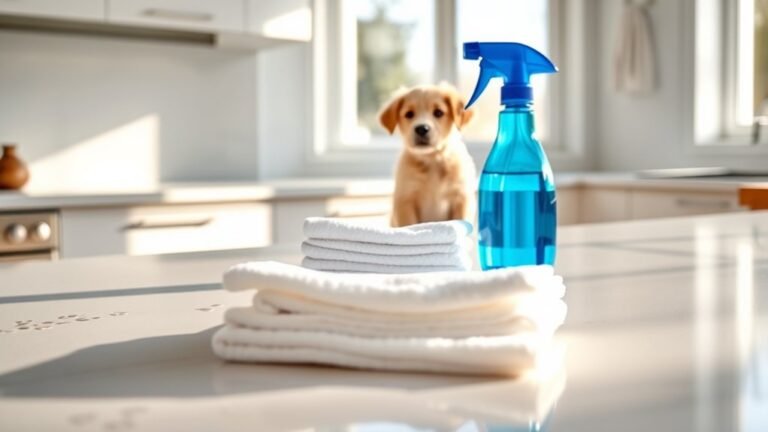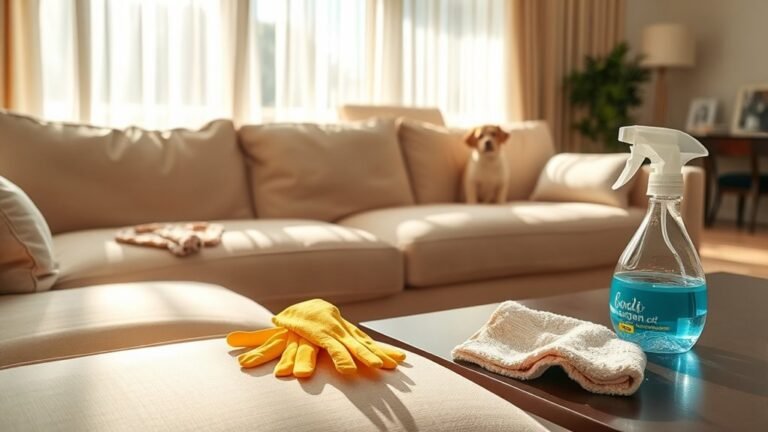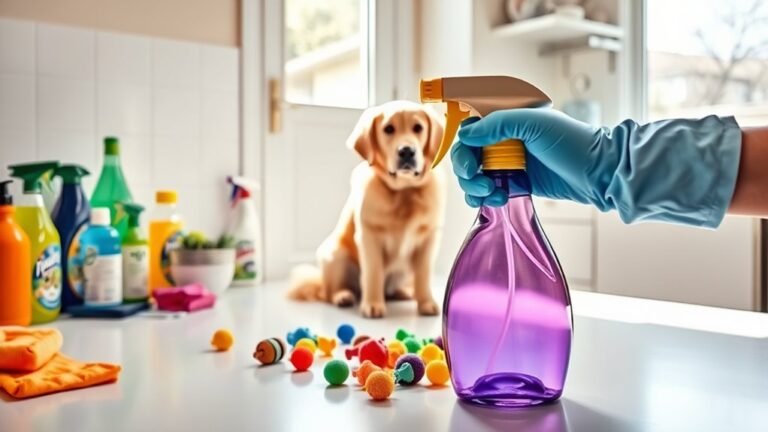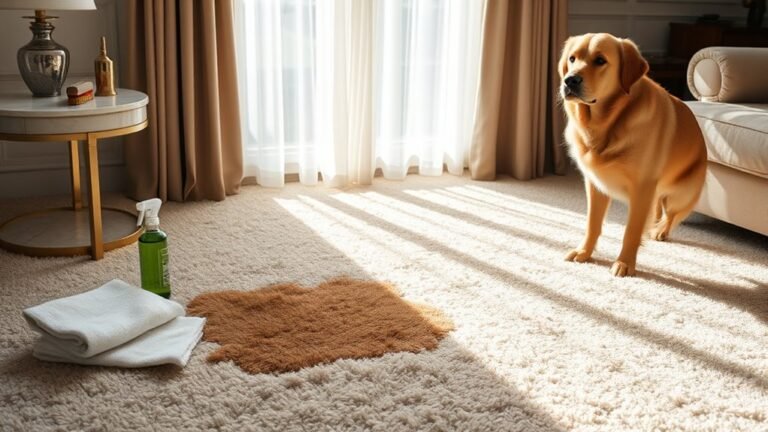Cleaning Strategies for Pet Grooming Salons
You need a regular cleaning schedule to keep your pet grooming salon safe and welcoming. Choose pet-safe, natural products to protect animals and your team. Use ultrasonic cleaners and steam sterilization for tools, plus efficient vacuums to manage fur. Dispose of waste properly, control air quality with humidity management, and maintain dry floors. Staff hygiene, including gloves and aprons, is essential. Handling stains and odors quickly keeps the space fresh. There’s more to creating a spotless, comfortable salon you’ll want to explore.
Importance of Regular Cleaning Schedules

Although it might seem time-consuming, sticking to a regular cleaning schedule is essential for keeping your pet grooming salon safe and inviting. When you commit to consistent cleaning, you not only meet health regulations but also create an environment where pets and their owners feel comfortable and cared for. This dedication boosts customer satisfaction, as clients appreciate a spotless, hygienic space that reflects professionalism and respect for their pets’ well-being. By following a set routine, you avoid last-minute scrambles and reduce stress, giving you freedom to focus on what you love—grooming. Remember, a clean salon isn’t just about appearances; it’s about maintaining a safe, healthy space where everyone can thrive. Your routine is key to keeping both pets and customers coming back.
Choosing Pet-Safe Cleaning Products
When selecting cleaning products for your pet grooming salon, you need to prioritize safety above all else. Choosing products with natural ingredients guarantees they’re gentle on pets’ skin and respiratory systems, while still effectively cleaning your space. Opting for eco friendly options not only protects animals but also reduces your environmental footprint, aligning with a freedom-focused mindset that values health and sustainability. Avoid harsh chemicals that can cause irritation or harm, and look for certifications or labels that verify pet-safe claims. By selecting the right cleaning agents, you create a safer, more inviting environment for both pets and staff, giving you peace of mind and the freedom to focus on what truly matters—providing excellent care without compromising safety.
Effective Disinfection Techniques for Grooming Tools
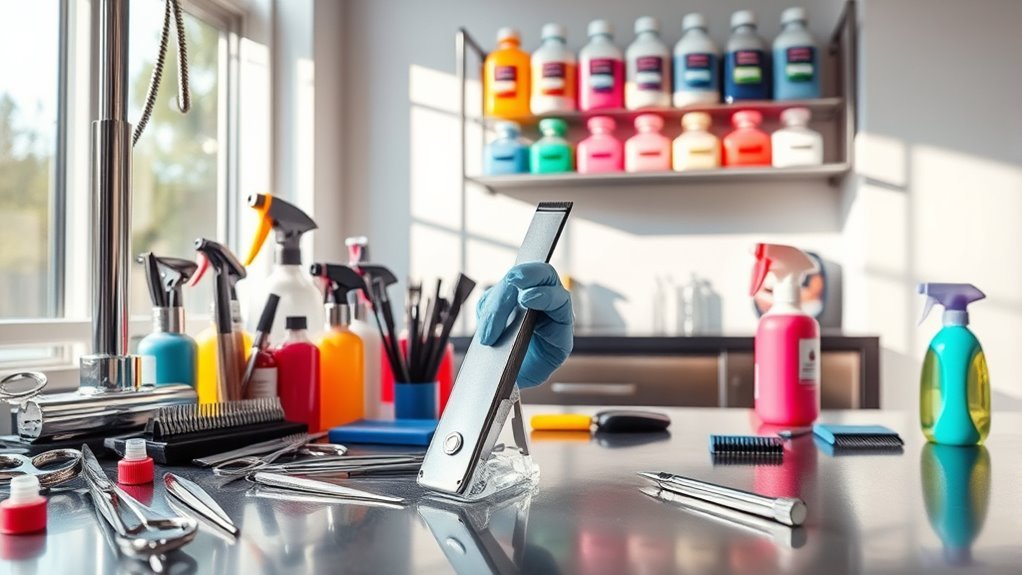
To keep your grooming tools safe and effective, you’ll need to use proper sterilization methods like autoclaving or UV light. Choosing safe chemical disinfectants is just as important to avoid harming pets or damaging equipment. Let’s explore the best techniques to guarantee your tools stay clean and hygienic.
Tool Sterilization Methods
Sanitizing your grooming tools is essential to prevent the spread of bacteria and keep pets safe. To maintain a clean, efficient salon, consider ultrasonic cleaners—they use high-frequency sound waves to remove dirt and microbes from tiny crevices, reaching places you can’t scrub by hand. This method saves time while ensuring tools like scissors and clippers are thoroughly cleaned.
For deeper sterilization, steam sterilization is your best bet. It uses high-pressure steam to kill all microorganisms, offering a chemical-free, eco-friendly way to guarantee your tools are safe for every pet. Incorporating these methods into your routine frees you from worries about contamination and keeps your grooming space professional and hygienic.
Safe Chemical Disinfectants
Although ultrasonic and steam sterilization are highly effective, using safe chemical disinfectants is still vital for thorough grooming tool sanitation. When choosing disinfectants, you want options that protect both your health and the environment. Natural disinfectant alternatives like vinegar or tea tree oil can be great, but they might not eliminate all pathogens. For stronger protection, use EPA-approved chemicals, but always follow chemical safety precautions—wear gloves, guarantee proper ventilation, and never mix chemicals. Proper contact time is essential; don’t rush the process. By balancing effective chemical use with natural alternatives and safety measures, you maintain a clean, safe space without compromising your freedom to work confidently. This approach keeps your tools germ-free and your conscience clear.
Managing Fur and Hair Removal Efficiently
When you’re running a pet grooming salon, managing fur and hair removal efficiently is key to keeping your workspace clean and safe. You want to embrace fur management techniques that save time and effort while preventing buildup. Using efficient vacuum systems designed for pet hair allows you to quickly clear fur from grooming tables, floors, and corners without hassle. Regularly scheduled cleanups paired with these tools keep your salon inviting and hygienic. Don’t overlook handheld vacuums or specialized attachments to target hard-to-reach spots. By integrating these practices into your routine, you free yourself from constant mess and focus more on your passion—caring for pets. Staying proactive with fur removal means less stress, a healthier environment, and a salon that welcomes both pets and their owners with ease.
Maintaining Clean and Dry Flooring

You’ll want to use slip-resistant floor mats to keep your grooming area safe and prevent accidents. Quick water absorption is key to stopping slippery spots before they become a hazard. Let’s explore how these tools can help maintain clean and dry flooring.
Slip-Resistant Floor Mats
Since wet and slippery floors pose a major hazard in pet grooming salons, using slip-resistant floor mats is essential to keep your workspace safe and clean. These mats offer slip resistant benefits by providing firm footing, reducing the risk of falls for you, your staff, and your furry clients. When choosing mat materials, consider options like rubber or textured vinyl, which deliver durability and excellent grip even when wet. You want mats that are easy to clean and resistant to chemicals commonly used in salons, ensuring they stay effective without extra hassle. By investing in the right slip-resistant floor mats, you’re not just enhancing safety—you’re also creating a more efficient environment that lets you focus on what matters most: grooming with freedom and confidence.
Rapid Water Absorption
Although spills and splashes are inevitable in pet grooming salons, rapid water absorption can keep your floors clean and dry, reducing slip hazards and maintaining a hygienic workspace. You’ll want to invest in highly absorbent materials like microfiber mats or specialized absorbent pads placed near washing stations. These materials soak up water instantly, preventing puddles from forming. Quick drying surfaces also help by minimizing moisture buildup, which not only keeps your space safer but also discourages mold and bacteria growth. By choosing flooring and mats designed for rapid water absorption, you free yourself from constant worry about slippery floors. This lets you focus on what matters—providing great care to pets—while enjoying the freedom of a clean, dry, and safe environment.
Proper Waste Disposal Methods
When managing a pet grooming salon, proper waste disposal methods are essential to maintain a clean and safe environment. You want to keep things organized and eco-friendly by focusing on waste segregation and composting practices. Separating organic waste like fur and biodegradable materials from plastics and chemicals helps reduce contamination and supports recycling efforts. Composting your organic waste can turn salon byproducts into valuable soil additives, cutting down landfill contributions. To make this easier, consider:
Proper waste disposal in pet salons ensures cleanliness and supports eco-friendly recycling and composting efforts.
- Setting up clearly labeled bins for different waste types
- Training staff on proper waste segregation
- Using compost bins for organic salon waste
- Disposing of hazardous materials per local regulations
- Scheduling regular waste pickups to avoid buildup
This approach keeps your salon fresh, safe, and aligned with sustainable values you want to uphold.
Ventilation and Air Quality Control
Ensuring proper ventilation is key to keeping air fresh and reducing odors in your pet grooming salon. You want a system that promotes consistent air exchange, bringing in clean air and pushing out stale, smelly air. This not only makes the space more pleasant but also helps control airborne contaminants that might bother both pets and clients. Don’t forget humidity control—it’s essential to prevent mold growth and maintain a comfortable environment. High humidity can worsen odors and promote bacteria, so investing in dehumidifiers or HVAC systems with moisture regulation is a smart move. By managing air exchange and humidity control effectively, you create a healthier, freer atmosphere where pets and people alike can breathe easy and feel comfortable throughout every grooming session.
Staff Hygiene and Protective Gear
Good air quality sets the stage for a clean grooming environment, but maintaining hygiene goes beyond just the air you breathe. You need to empower your team with thorough staff training focused on hygiene policies and protective gear use. This guarantees everyone stays safe and your salon remains spotless.
Make sure your staff:
- Wash hands before and after each pet
- Wear gloves when handling shampoos or chemicals
- Use clean aprons or smocks daily
- Change footwear or use shoe covers to avoid cross-contamination
- Keep hair tied back or covered during grooming
Handling Stains and Odors Promptly
Although stains and odors can seem inevitable in a pet grooming salon, addressing them quickly is key to keeping your space fresh and inviting. When you spot a mess, tackle stain removal right away using pet-safe cleaners designed to break down proteins and oils. This prevents stains from setting and keeps surfaces looking clean. For odor neutralization, don’t just mask smells—use enzymatic products that eliminate odors at their source, ensuring the air stays pleasant for both pets and clients. Quick action means less buildup, fewer complaints, and a more comfortable environment where everyone feels free and at ease. Staying vigilant about stains and odors lets you maintain a professional, welcoming salon without hassle or compromise.
Frequently Asked Questions
How Often Should Grooming Tools Be Replaced Instead of Cleaned?
You should replace grooming tools when you notice clear replacement indicators like dull blades, rust, or damage that cleaning can’t fix. Tool lifespan varies depending on usage and quality, but staying attentive helps you avoid risking your pet’s comfort or safety. Don’t wait too long—trust your instincts and keep tools sharp and reliable so you can work freely without worrying about ineffective equipment holding you back.
What Are the Best Practices for Cleaning Pet Grooming Salon Waiting Areas?
You might think waiting areas don’t need much attention, but maintaining high-quality waiting area aesthetics is essential for your salon’s vibe and client comfort. To truly respect sanitation regulations, you’ve got to clean seating, floors, and surfaces frequently, using pet-safe disinfectants. Keeping things fresh and clutter-free not only meets health standards but also gives you the freedom to create a welcoming space where both pets and owners feel relaxed and valued.
How Do Seasonal Changes Affect Cleaning Routines in Pet Salons?
Seasonal changes can really shake up your cleaning routine because of temperature fluctuations and seasonal allergens. When it’s warmer, you’ll notice more pollen and dust sneaking into the salon, so you’ll need to clean surfaces and air filters more often. Cooler months might bring in mud and moisture, requiring extra floor attention. Staying flexible with your schedule lets you keep the space fresh and comfy for both pets and people, no matter the season.
Are There Specific Cleaning Protocols for Exotic Pet Grooming?
When dealing with exotic pet hygiene, you’ll need to follow specific cleaning protocols to keep things safe and sanitary. You can’t just use standard tools; specialized equipment designed for unique skin, scales, or feathers is a must. This helps prevent disease and stress for your exotic clients. It’s all about adapting your routine to their unique needs, giving both you and the pets the freedom to enjoy grooming without worry.
How to Train New Staff on Salon Cleaning Procedures Effectively?
Imagine a smooth-running salon where every corner shines because your team knows exactly what to do. To train new staff effectively, start with a clear staff onboarding process that includes detailed cleaning checklists. These checklists guide them step-by-step, making the job less overwhelming and more freeing. Combine hands-on demonstrations with flexible learning options, so they feel confident and empowered, not restricted, while mastering your salon’s cleaning procedures.

